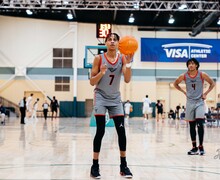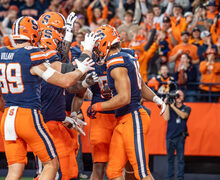Next level: After breakout sophomore season, Carter-Williams bound for NBA Draft lottery
Nate Shron | Staff Photographer
Syracuse point guard Michael Carter-Williams led the Big East with 7.3 assists per game. He's a projected lottery pick in June's NBA Draft.
It was in his sophomore year of high school that Michael Carter-Williams started to blossom.
That was when Mike Hart and Leo Papile, his two coaches at the time, saw his transformation from a skinny kid from Hamilton, Mass., to a fierce competitor whose sheepishness vanished when he stepped onto the court.
“He was shy, but you could tell that he was going to hit a growth spurt and break out,” Hart said. “It was a matter of refining his skills and using his length and, once he started to, a very good basketball player was born.”
They instantly knew that Carter-Williams could play not just at the collegiate level, but also beyond.
Carter-Williams is foregoing his final two years of college eligibility and entering June’s NBA Draft. After leading SU to the Final Four at the end of his sophomore season, he will use his recent success to achieve his lifelong dream of playing professional basketball. But some see him as incomplete. Still, his former coaches have seen him face scrutiny before and grow stronger as a result. To them, his ascension to an NBA prospect couldn’t have come at a better time.
“Michael just loves basketball,” Papile said. “I think if his career would have ended at Syracuse he would have been fine with that, but thankfully that’s not the case. The kid is going to do whatever he needs to do to get better.”
At times, growth has been a daunting task for Carter-Williams. Now, as he nears a milestone that will validate a lifetime of work, growth defines him as a basketball player.
When Carter-Williams moved from Hamilton-Wenham Regional High School in Hamilton, Mass., to St. Andrew’s in Rhode Island before his sophomore year, he stood 5 feet 9 inches tall.
He was far from his eventual size, and his guard skills were undeveloped, but right away Carter-Williams reminded Hart of a player he had coached at Adidas’ ABCD Camp.
“First thing I thought was Shaun Livingston,” Hart said referring to the veteran NBA guard currently playing for the Cleveland Cavaliers. “Right when we started working Michael out he played like him and he looked like him, and when I saw the comparisons I knew we had something special on our hands.”
Hart, Carter-Williams’ high school coach at St. Andrew’s School in Barrington, R.I., has worked with NBA players LeBron James and Dwight Howard, among others, through his affiliation with Adidas.
Papile, the head coach and founder of Carter-Williams’ former AAU organization the Boston Amateur Basketball Club, has evaluated talent at all levels. Most notably, he served as the Boston Celtics’ senior director of basketball operations for 14 years.
St. Andrew’s struggled in Carter-Williams’ sophomore season, but that didn’t stop him from growing in size, talent and mind. After hitting his growth spurt he not only made high school and AAU basketball his playground, but also a place to improve.
He started to dominate in the pick-and-roll offense, understand team defense, develop a mental toughness beyond his years and use his newly acquired size to set himself apart.
“Michael always had length, but once he hit his growth spurt his physical package made him unique,” Papile said. “A 6-6 point guard is like having a 6-8 quarterback in football. Guys like that don’t come around too often.”
As Carter-Williams neared the end of high school, many were still skeptical of his ability to compete at the next level. In Carter-Williams’ senior season, St. Andrew’s played DeMatha Catholic (Md.), at the Cancer Research Classic in Wheeling, W.V.
DeMatha’s starting lineup consisted of current Georgetown forward Mikael Hopkins, Pittsburgh point guard James Robinson and Syracuse forward Jerami Grant.
Despite the Stags’ abundance of talent, St. Andrew’s had a leader in Carter-Williams that couldn’t be contained. After missing a dunk early in the game it seemed that Carter-Williams was shrinking in the spotlight. He then led St. Andrew’s to a 22-point fourth quarter and a 49-46 upset win.
Carter-Williams finished the game with 26 of his team’s 49 points and posted six rebounds, six steals and three assists. He won the tournament’s MVP award over Hopkins, Robinson, Grant and Northland High School’s Trey Burke.
“It was his senior season and people were really doubting Mike,” Hart said. “But that DeMatha game turned all the heads that weren’t turned yet. That was the kind of game where I just let him loose and watched in awe.”
It has been two years and four months since Carter-Williams almost single-handedly took down DeMatha, and the doubting still persists. Even after leading Syracuse to the Big East championship game and the Final Four, there are glaring holes in his game that will affect his draft stock.
Carter-Williams finished tied for third in the nation and first in the Big East with 7.3 assists per game last season, while averaging a respectable 11.9 points. But he also averaged close to 3.5 turnovers and shot 39.3 percent from the field, 29.2 percent from 3 and 69.4 percent from the line. Additionally, he has played in Jim Boeheim’s zone defense, but has not shown the ability to defend man-to-man.
Jonathan Givony of Draftexpress.com is especially hesitant to call Carter-Williams “NBA ready.” Givony recognizes Carter-Williams’ point guard skills and rare size, but doesn’t see what he will bring to an NBA franchise in the near future.
“He’s not a consistent shooter at all — that is his main limitation,” Givony said. “He also can make bad decisions and is turnover prone, and will need to work on that.
“A team can’t expect him to be a prolific scorer or do too much without the help of others, and that will make a lot of franchises consider passing up on him.”
Draftexpress.com currently has Carter-Williams being selected at the back end of the 14-team lottery. Since the draft order will not be set until the conclusion of the NBA season, he is currently ranked based on talent alone.
Carter-Williams is no stranger to being told he is behind, and Papile is confident that he’ll use these obstructions as fuel to keep moving forward.
“He has to start knocking down 1,000 jump shots a day and knowing him very well, that is something he will do,” Papile said. “He has to live and die by getting better each and every day from here on out.”
As the draft nears, teams are aware of Carter-Williams’ flaws, but his work ethic and competitive edge wowed scouts. He has impressed with his maturity, and also his ability to improve and adapt.
“At Syracuse he played in so many big games and so many big moments,” Givony said. “That kind of exposure will help any prospect, showing that they can be part of a winning situation. His experience so far is invaluable.”
Once, Carter-Williams was too small to be a Division-I basketball player; then he grew. When his guard skills were put into question, he studied the game, worked on his fundamentals and grew.
When it was said that he couldn’t be the leader of an elite college basketball team, he grew with each pass and each game-clinching bucket, lifting Syracuse to its best finish since winning the National Championship in 2003.
And when commissioner David Stern calls his name at the NBA Draft in June, Carter-Williams will silence all of those who said he couldn’t, and grow once again.
“I have never known Michael to be content with his play,” Hart said. “The kid is special, he comes from a special family and will do special things. With his work ethic, the sky is the limit.”
Published on April 30, 2013 at 12:59 am
Contact Jesse: jcdoug01@syr.edu | @dougherty_jesse





